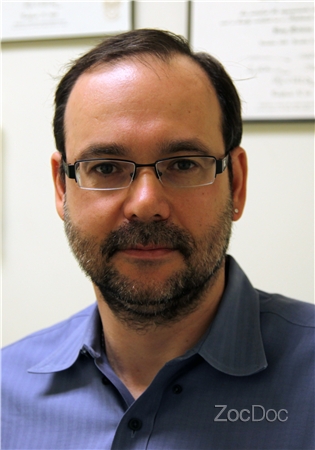Top Treatments for Pediatric Sleep Apnea: 10 Options
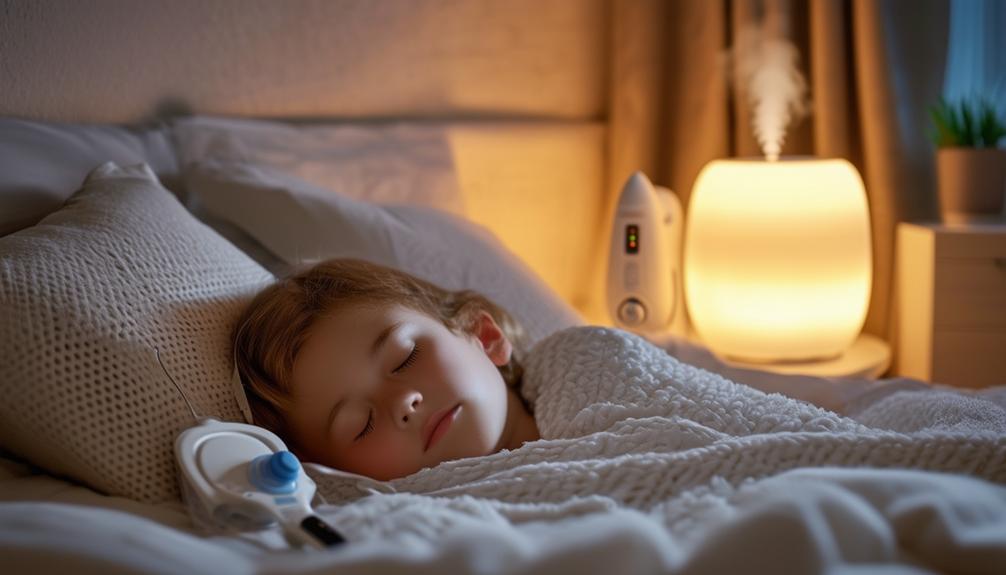
Treating pediatric sleep apnea effectively can greatly enhance your child's well-being. Start with lifestyle changes like weight management and creating a sleep-friendly environment. Positive-pressure ventilation (CPAP) helps maintain stable oxygen levels. Oral appliances and nasal steroids can also ease symptoms. For more severe cases, consider surgical interventions like adenotonsillectomy or tongue reduction. Tracheotomy is an option for critical cases. Additionally, bariatric surgery may be suitable for adolescents with severe obesity. Regular follow-up visits and long-term monitoring guarantee sustained improvements. By exploring these treatments, you can pave the way for better sleep and overall health for your child.
Noteworthy Details
- Lifestyle Changes: Implement weight management, regular physical activity, and minimize allergens to improve sleep apnea symptoms.
- Positive-Pressure Ventilation (CPAP Therapy): Delivers continuous airflow to maintain stable oxygen levels and reduce snoring.
- Adenotonsillectomy: Surgically removes tonsils and adenoids to improve sleep quality with a high success rate.
- Oral Appliances: Custom-made devices reposition the jaw to keep the airway open, suitable for mild to moderate cases.
- Nasal Steroids: Reduce nasal passage inflammation to ease breathing and improve sleep quality.
Lifestyle Changes
In tackling pediatric sleep apnea, implementing lifestyle changes such as weight management through diet and regular exercise can greatly improve your child's sleep quality. Childhood obstructive sleep apnea often correlates with excess weight, making weight management vital. By encouraging your child to engage in regular physical activity, you can help them maintain a healthy weight, reducing the severity of sleep apnea symptoms.
Beyond weight management, it's important to create a sleep-friendly environment. This means minimizing exposure to allergens and irritants in your child's bedroom. Dust mites, pet dander, and mold can worsen Pediatric Sleep Apnea symptoms, so make sure that their sleeping area is clean and allergen-free.
Establishing a consistent bedtime routine can also be transformative. A predictable schedule helps signal to your child's body that it's time to wind down. Limit screen time before bed and incorporate relaxation techniques like reading or gentle stretching. Consistency in this routine fosters a sense of security and belonging, ultimately promoting better sleep patterns.
Positive-Pressure Ventilation
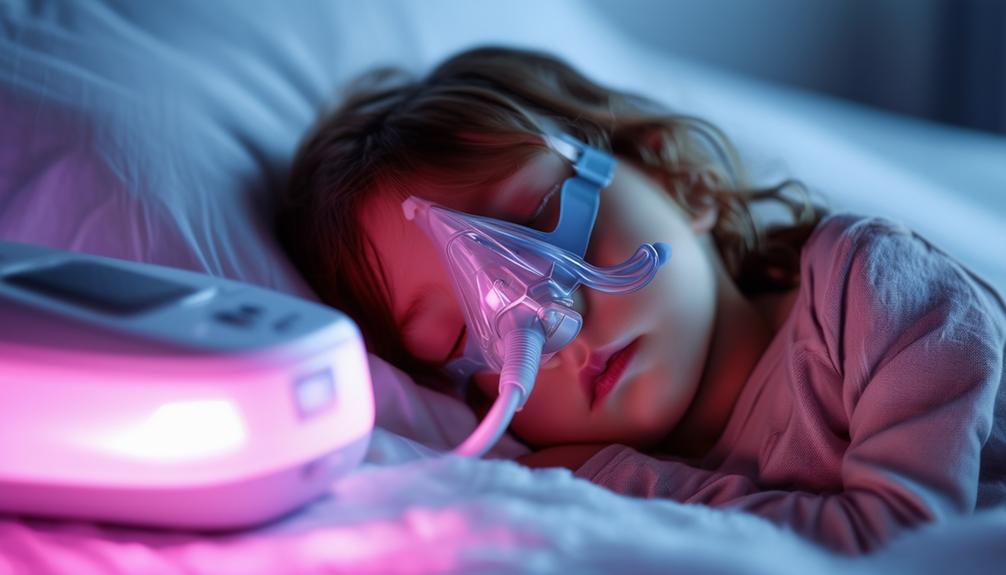
When considering positive-pressure ventilation, you'll find that CPAP therapy is particularly effective for children with sleep apnea.
It works by delivering a continuous flow of air through a mask, keeping your child's airway open and preventing breathing pauses.
This method not only improves oxygen levels but also reduces symptoms like snoring and daytime sleepiness, making a significant difference in their sleep quality and overall health.
How It Works
Positive-pressure ventilation, particularly through CPAP, delivers a steady stream of pressurized air via a mask, ensuring your child's airways remain open throughout the night. This approach is especially effective for managing pediatric sleep apnea, a condition characterized by repetitive airway collapse and breathing interruptions. By preventing these collapses, CPAP helps maintain stable oxygen levels, vital for your child's overall health and well-being.
When using CPAP, your child wears a mask connected to a machine that provides a constant flow of air. This pressurized air acts as a splint, keeping the airway passages open and reducing the likelihood of breathing interruptions. The consistent airflow ensures that your child can breathe normally, which helps to improve sleep quality and reduce daytime sleepiness.
The process is non-invasive, making it a suitable option for many children. It's important to make sure the mask fits properly to maximize comfort and effectiveness. Adherence to this treatment can greatly reduce the risks associated with pediatric sleep apnea, such as cardiovascular issues and developmental delays.
Benefits for Children
Adopting CPAP therapy can lead to significant improvements in your child's sleep quality, behavior, and overall cognitive function. Positive airway pressure, specifically CPAP therapy, is a highly effective treatment option for children suffering from obstructive sleep apnea. By keeping their airway open during sleep, CPAP prevents the frequent breathing interruptions that characterize this condition.
Children who use CPAP therapy often experience a marked enhancement in sleep quality, leading to better daytime behavior and attention span. Improved sleep directly impacts cognitive functions, making it easier for your child to focus and learn in school. Additionally, the consistent use of CPAP therapy can reduce the risk of long-term complications associated with pediatric sleep apnea, promoting better overall health.
This non-invasive treatment is well-tolerated by many pediatric patients, making it a practical choice for managing obstructive sleep apnea. The benefits extend beyond improved sleep; they include enhanced mood and decreased irritability, which can foster a more harmonious family environment.
Usage and Maintenance
Ensuring your child's CPAP machine is properly maintained is essential for effective treatment and their overall comfort. CPAP therapy, a common solution for pediatric sleep apnea, relies on the consistent delivery of positive airway pressure. To achieve this, CPAP machines must be kept in top condition.
First, focus on the mask fit. An essential mask fit can cause skin irritation and disrupt sleep. Regularly check and adjust the mask to ensure it fits snugly yet comfortably.
Secondly, cleaning is vital. Daily cleaning of the mask and weekly cleaning of the hose and humidifier chamber will prevent the buildup of bacteria and mold, which could impact your child's health.
Lastly, monitor the air pressure settings. Incorrect settings can reduce the effectiveness of the treatment. Consult your healthcare provider to verify the best air pressure for your child's needs.
Here's a quick reference for maintaining CPAP machines:
| Maintenance Task | Frequency | Importance |
|---|---|---|
| Check mask fit | Daily | Ensures comfort and prevents skin irritation |
| Clean mask | Daily | Reduces risk of infections |
| Clean hose and chamber | Weekly | Prevents mold and bacteria buildup |
| Verify air pressure | Regularly | Ensures effective treatment |
Oral Appliances
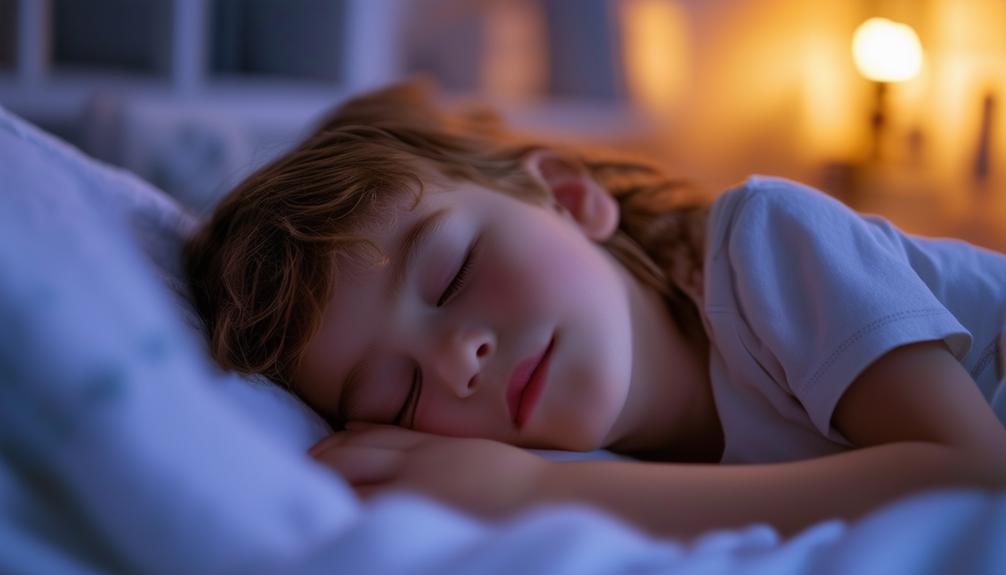
Oral appliances are custom-made devices that reposition your child's jaw to keep the airway open during sleep. They're a great option for children with mild to moderate sleep apnea who can't tolerate CPAP masks.
These appliances are well-tolerated and can greatly reduce symptoms like snoring and breathing pauses, but regular follow-up visits with a dentist or orthodontist are essential to make sure they fit and work effectively.
How Oral Appliances Work
Repositioning the jaw and tongue, oral appliances keep your child's airway open during sleep, offering a non-invasive solution for managing mild to moderate pediatric sleep apnea. These devices are custom-made to fit comfortably and securely in your child's mouth, ensuring ideal effectiveness.
By adjusting the jaw and tongue positioning, oral appliances help maintain an open airway, reducing the frequency and severity of sleep apnea symptoms.
Oral appliances are often preferred over surgery or CPAP therapy for their ease of use and adjustability. They can be titrated, meaning they can be gradually adjusted to find the most effective position for improving your child's breathing during sleep.
This precision in jaw and tongue repositioning helps to tailor the treatment to your child's specific needs.
Regular follow-ups with a healthcare provider are essential. These appointments ensure the device remains effective and comfortable as your child grows. Adjustments may be needed over time to maintain the appliance's fit and functionality.
Benefits for Children
By selecting oral appliances for your child's sleep apnea, you'll notice significant improvements in their overall sleep quality and daytime alertness. These non-invasive treatment devices are custom-made to fit comfortably in your child's mouth, guaranteeing they can wear them without discomfort. Oral appliances are specifically designed to enhance airflow during sleep by repositioning the jaw or tongue, which helps prevent airway obstruction.
For children with mild to moderate pediatric sleep apnea, oral appliances can be particularly efficient. While tonsils and adenoids might be contributing to airway blockage, oral appliances work differently by focusing on optimizing the position of oral structures. This can be advantageous, especially if your child isn't a candidate for surgical interventions or if you prefer a less invasive approach.
Regular follow-up visits with a dentist or orthodontist are crucial. These professionals will adjust the appliance as needed to ensure it continues to perform at its best. This ongoing care ensures that your child's treatment remains effective over time.
Oral appliances are also portable, making them convenient for travel or overnight stays, allowing your child to maintain their treatment routine consistently. By opting for this treatment, you provide a manageable and effective solution for your child's sleep apnea.
Nasal Steroids
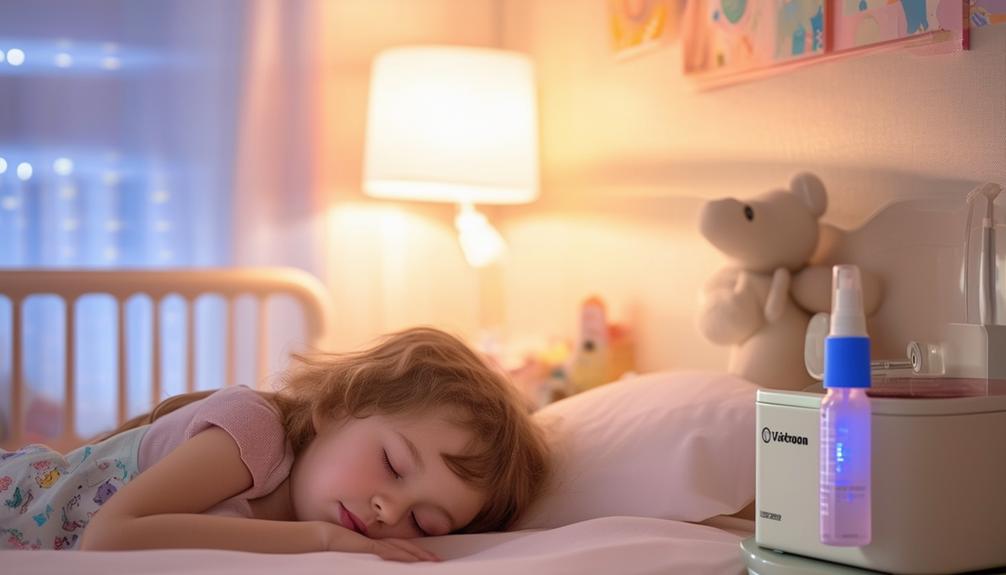
Nasal steroids can greatly reduce inflammation in the nasal passages, making it easier for children with sleep apnea to breathe during the night. For children dealing with pediatric sleep apnea, particularly mild obstructive sleep apnea, nasal steroids are a promising treatment option. These medications work by decreasing inflammation in the nasal passages, which improves airflow and lessens nasal congestion.
Nasal steroids are typically available as sprays or drops, making them easy to administer. When integrated into a thorough treatment plan, these medications can significantly lessen nasal swelling. This helps children breathe more easily during sleep, thereby reducing the severity of sleep apnea symptoms. It's particularly beneficial for children who've nasal allergies contributing to their obstructive sleep apnea.
Using nasal steroids as part of a treatment plan for pediatric sleep apnea can lead to better overall sleep quality. Improved sleep not only enhances daytime alertness and mood but also reduces associated health risks such as cardiovascular issues and behavioral problems.
Adenotonsillectomy
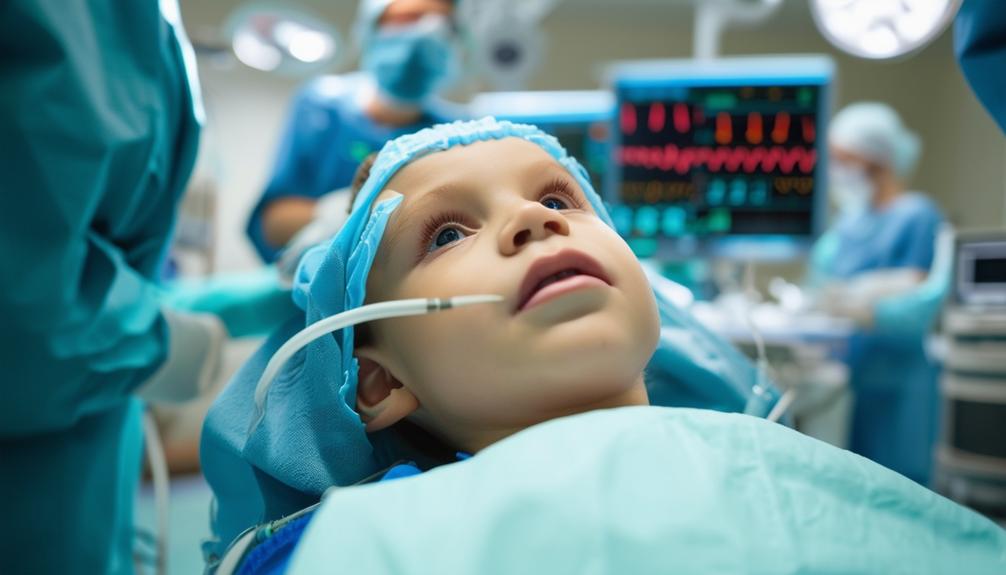
You should be mindful that an adenotonsillectomy involves surgically removing the tonsils and adenoids to treat pediatric sleep apnea.
This procedure typically has a high success rate, greatly improving sleep quality and overall health in children.
However, it's important to take into account the potential risks and complications, as well as the recovery time, when evaluating this treatment option.
Procedure and Recovery Time
Adenotonsillectomy, a procedure where the tonsils and adenoids are surgically removed, is often recommended to alleviate pediatric sleep apnea and greatly improve a child's sleep quality. This surgical treatment is one of the most effective options for reducing the symptoms of sleep apnea in children.
The recovery time is typically 1-2 weeks, during which children gradually return to their normal activities. Post-surgery, children may experience throat discomfort and mild pain, which can be managed with prescribed pain relievers. It's important for children to have changes in their diet, often requiring softer foods and plenty of fluids to aid in healing. Activity restrictions are also advised, especially avoiding strenuous activities that could impact the recovery process.
Regular follow-up visits with healthcare providers are essential to monitor the child's progress and ensure they're healing properly. These visits help in addressing any concerns and making any necessary adjustments to the recovery plan.
Success Rates and Benefits
Undergoing adenotonsillectomy often brings about a dramatic improvement in sleep quality and overall well-being for children suffering from obstructive sleep apnea. This surgical procedure boasts a success rate of around 80-90% for treating pediatric sleep apnea, making it a highly effective option.
Post-surgery, many children experience significant benefits, including improved sleep quality and decreased daytime sleepiness, which can substantially enhance their daily lives.
One of the most notable benefits of adenotonsillectomy is its positive impact on cognitive function and attention span. Studies have shown that children who undergo the procedure often exhibit marked improvements in these areas, leading to better performance in school and more effective social interactions. Additionally, behavioral problems often decrease, resulting in a more harmonious home environment.
Another key advantage is the potential for better growth and development. Children with untreated sleep apnea often face growth challenges, but adenotonsillectomy can help reverse these issues by ensuring they get the quality sleep necessary for development.
Given its high success rates and multiple benefits, adenotonsillectomy is considered a first-line treatment for moderate to severe cases of pediatric obstructive sleep apnea.
Potential Risks and Complications
While adenotonsillectomy offers substantial benefits for children with obstructive sleep apnea, it's important to recognize that the procedure carries potential risks and complications. Understanding these can help you make informed decisions about your child's health. Although complications are rare, they can occur and require careful attention.
- Bleeding: One of the most significant potential risks is postoperative bleeding. This could happen within the first 24 hours or even up to two weeks after surgery. Monitoring for signs of excessive bleeding is vital.
- Infection: Despite being a routine procedure, adenotonsillectomy can sometimes lead to infections. Symptoms like fever, increased pain, or unusual discharge should prompt immediate medical consultation.
- Respiratory Issues: In some cases, children may experience breathing difficulties post-surgery. This is more likely in children with underlying respiratory conditions and requires close postoperative monitoring.
Postoperative risks like dehydration, pain, and difficulty swallowing are commonly managed with appropriate care. Proper hydration and pain management can greatly improve your child's recovery.
Consulting a pediatric otolaryngologist is essential to discuss these potential risks and benefits thoroughly. This ensures you're well-prepared, fostering a sense of belonging and trust in the care process for your child facing pediatric sleep apnea.
Uvulopalatopharyngoplasty
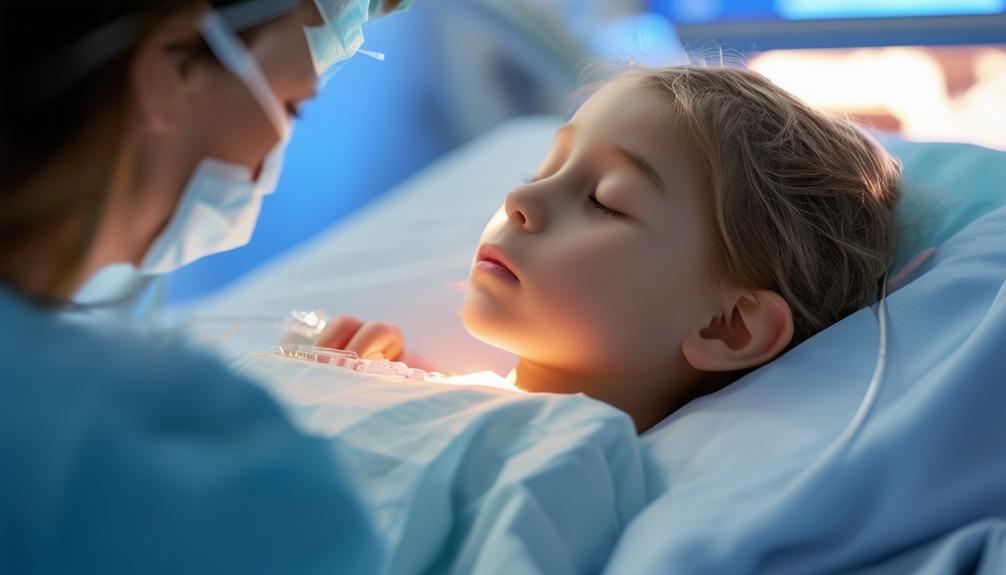
Uvulopalatopharyngoplasty (UPPP) is a surgical intervention specifically designed to alleviate pediatric obstructive sleep apnea by excising excess tissues in the throat, thereby broadening the airway. This surgical procedure typically involves trimming the soft palate, uvula, and sometimes the tonsils. For children suffering from obstructive sleep apnea, UPPP can be a highly effective treatment, especially when other interventions like CPAP therapy or adenotonsillectomy haven't brought the desired relief.
During the UPPP procedure, the surgeon will remove or reshape tissues that block the airway during sleep. This can notably reduce symptoms such as snoring, breathing pauses, and daytime sleepiness. However, it's important to understand that recovery can involve some discomfort. Your child might experience a sore throat and need to follow a restricted diet and activity level for a few weeks post-surgery.
The long-term benefits of UPPP can be quite substantial, improving not just sleep quality but also overall daytime functioning. By addressing the root cause of the airway obstruction, this procedure helps your child achieve more restful and uninterrupted sleep, contributing positively to their growth and development.
Tongue Reduction
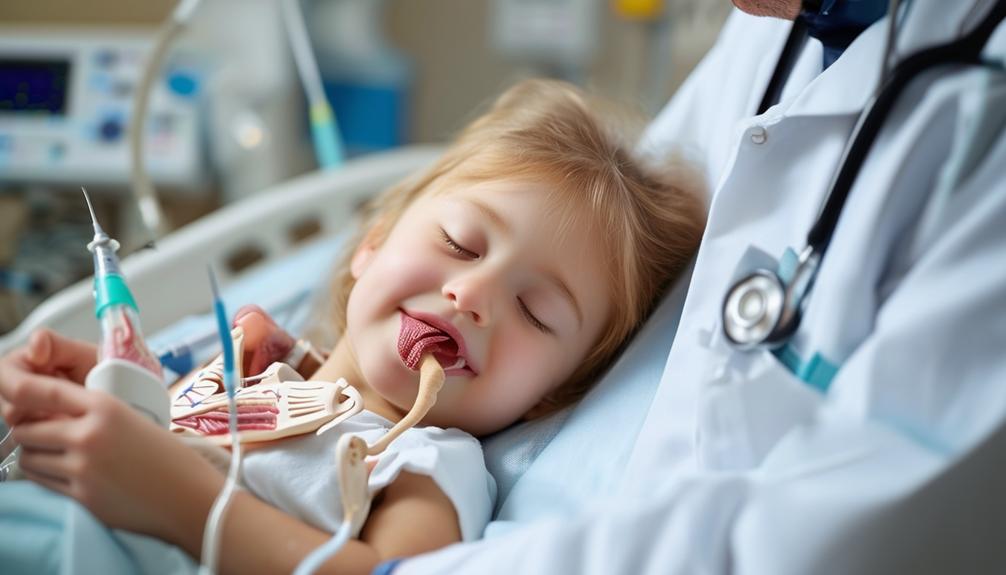
Tongue reduction surgery offers a targeted solution for children with obstructive sleep apnea caused by an enlarged tongue, enhancing their breathing and overall sleep quality. This procedure specifically addresses airway obstruction by reducing the tongue's size, thereby creating more space in the throat. For kids suffering from pediatric sleep apnea due to a large or obstructive tongue, this surgery can greatly improve their symptoms.
The primary aim of tongue reduction surgery is to provide breathing improvement, which in turn, alleviates sleep apnea symptoms and boosts the child's overall sleep quality. This treatment is typically considered when other interventions, like adenotonsillectomy or CPAP therapy, haven't been completely effective.
Here's why you might consider tongue reduction surgery for your child:
- Targeted Approach: It directly addresses the root cause of airway obstruction caused by the tongue's size.
- Breathing Improvement: By reducing the tongue's size, it enhances airway space, leading to better breathing during sleep.
- Quality of Sleep: Improved breathing reduces sleep disturbances, promoting restful and restorative sleep for your child.
Choosing tongue reduction surgery can be an important step toward ensuring your child enjoys better sleep and overall well-being.
Tracheotomy
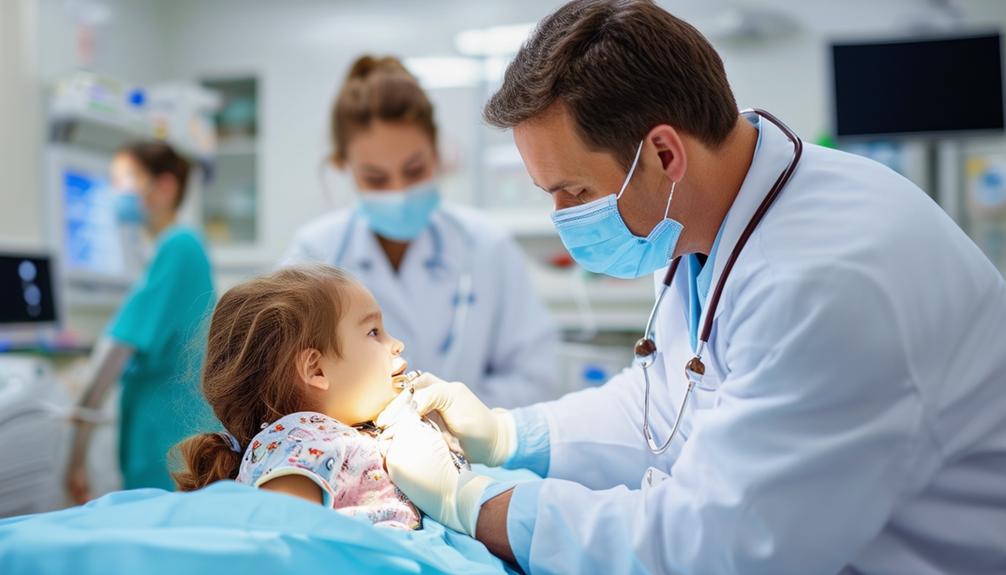
When other treatments for pediatric sleep apnea, such as tongue reduction surgery or CPAP therapy, fail to provide relief, a tracheotomy may be considered as an important intervention to ensure your child can breathe properly during sleep. This procedure is particularly valuable for severe cases of upper airway obstruction, where other measures have proven ineffective.
A tracheotomy involves creating a surgical opening in the neck and inserting a tube into the windpipe. This bypasses the obstructed upper airway, ensuring continuous airflow and preventing the breathing interruptions that characterize sleep apnea. Despite being a last resort option due to its invasive nature and potential long-term implications, a tracheotomy can be life-saving for children facing severe obstructive sleep apnea.
The decision to proceed with a tracheotomy is typically made by a multidisciplinary team of specialists who meticulously evaluate your child's condition. This team considers the risks and benefits associated with the procedure, ensuring that it's the best course of action for your child.
While the thought of surgery can be challenging, knowing that a dedicated team is working together to safeguard your child's health can provide a sense of belonging and reassurance.
Bariatric Surgery

Bariatric surgery offers a thorough option for adolescents with severe obesity and sleep apnea, aiming to alleviate symptoms by promoting substantial weight loss and enhancing overall health. This treatment option becomes particularly relevant when other interventions haven't shown success.
Here's what you need to know:
- Substantial Weight Loss: Bariatric surgery promotes considerable weight loss, which directly impacts the severity of pediatric sleep apnea. Reduced weight can lessen airway obstruction, making it easier for your child to breathe at night.
- Improved Sleep Apnea Symptoms: Studies reveal that adolescents undergoing bariatric surgery often experience noticeable improvements in sleep apnea symptoms. This means fewer disruptions during sleep, better oxygen levels, and overall enhanced sleep quality.
- Enhanced Quality of Life: By addressing severe obesity and sleep apnea simultaneously, bariatric surgery can greatly boost your child's overall well-being. Improved sleep can lead to better mood, energy levels, and academic performance.
It's essential to have a detailed discussion with your healthcare provider to weigh the potential risks and benefits of bariatric surgery for your child. This treatment option might just be the key to transforming your adolescent's health and daily life, offering a thorough solution to both severe obesity and pediatric sleep apnea.
Long-Term Monitoring
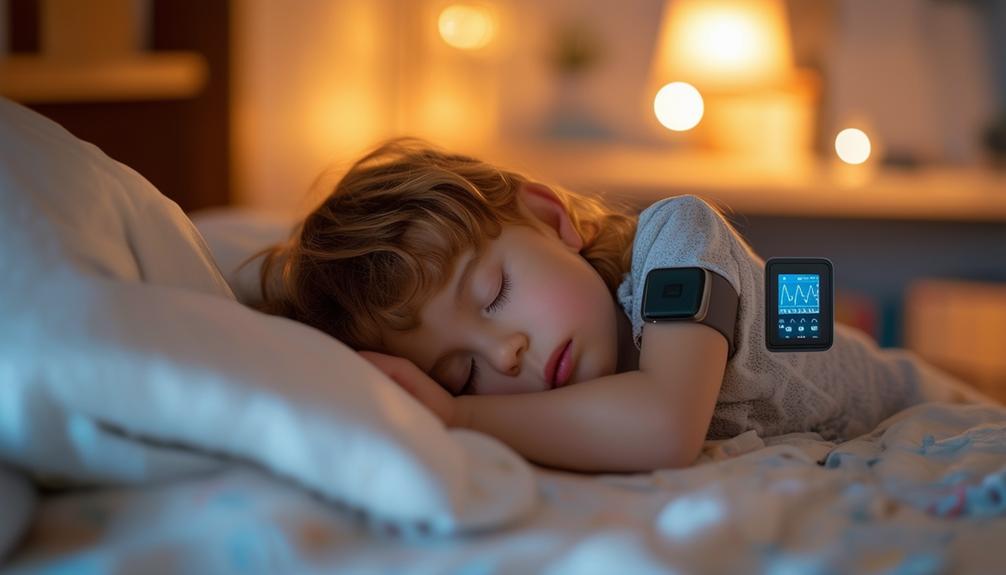
After successfully undergoing treatments like bariatric surgery, long-term monitoring becomes essential to ensuring sustained improvements in pediatric sleep apnea and overall health. You'll need to schedule regular follow-up appointments to evaluate the effectiveness of the treatment and catch any recurrence of symptoms early. These appointments are critical for maintaining your child's progress and ensuring their well-being.
Periodic sleep studies play an important role in this monitoring process. By repeating these studies, healthcare providers can closely examine changes in your child's sleep patterns and breathing. This data is invaluable for making any necessary adjustments to their treatment plan.
Monitoring your child's growth and development is equally significant. You want to ensure that the treatment for pediatric sleep apnea isn't negatively impacting their overall health. Regular assessments can help track their physical and developmental milestones.
Behavioral changes and improvements in academic performance should also be observed. These indicators can provide a clearer picture of how the treatment is enhancing your child's quality of life. Long-term monitoring allows healthcare providers to offer continuous support, adapting treatment plans as needed to ensure your child thrives.
Frequently Asked Questions
What Are the Treatment Options Available for OSA in Children?
You can explore adenoid removal, weight management, allergy treatment, orthodontic appliances, nasal steroids, and myofunctional therapy. These clinically-proven options are designed to help your child breathe easier and improve their overall sleep quality.
What Is the Best Way for a Child to Sleep With Sleep Apnea?
Guarantee your child maintains proper sleep positioning by sleeping on their back or side, incorporates a consistent bedtime routine, maximizes room environment and sleep hygiene, manages weight, and uses the right pillow type for best breathing.
What Is the Most Successful Treatment for Sleep Apnea?
The most successful treatment for sleep apnea is adenotonsillectomy. However, you can also consider behavioral therapy, nasal steroids, weight management, dental appliances, positional therapy, and other surgical options to help manage your child's condition effectively.
What Is the Gold Standard Treatment for Sleep Apnea?
Wondering about the gold standard treatment for pediatric sleep apnea? Adenotonsillectomy's effectiveness is unparalleled, often resolving symptoms. Alternatives like CPAP machines, weight management, allergy control, orthodontic intervention, and positional therapy also play roles, but surgery leads.
Conclusion
When it comes to treating pediatric sleep apnea, there's no one-size-fits-all solution. From lifestyle changes to surgeries like adenotonsillectomy, each option has its place.
Remember, 'an ounce of prevention is worth a pound of cure.' Regular monitoring and timely interventions can make a world of difference.
Consult with your child's healthcare provider to tailor the best treatment plan, ensuring your child gets the restful sleep they need for healthy growth and development.

